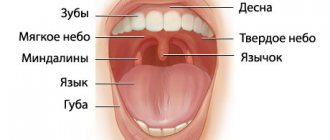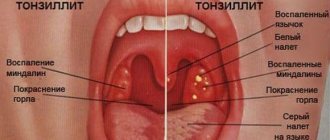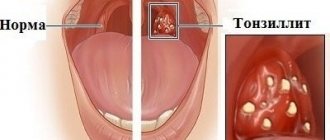Tonsillitis is an inflammation of areas of lymphoid tissue (tonsils) located on the back wall of the pharynx. They protect the body from the penetration of potentially dangerous viruses or bacteria, but in some cases they themselves can become infected. In many acute cases, the disease is viral in nature, so tonsillitis can be treated without the use of antibiotics. The chronic form of the disease is associated with the long-term existence of bacteria in the tonsil tissue. It requires complex therapy, and in some cases, surgical intervention. Tonsillitis most often affects children, but it can develop in people of any age.
Exacerbation of chronic tonsillitis: symptoms
Often, for a long time, chronic tonsillitis occurs without symptoms or has scanty symptoms (in a simple form). There may be discomfort when swallowing food and liquids, a sensation of a foreign body in the throat, dry mouth, halitosis (bad odor) and tingling. Externally, the tonsils increase in size and there are signs of inflammation. The disease is characterized by exacerbations of sore throats up to three times a year, long periods of recovery, with general symptoms of asthenia and prolonged low-grade fever.
For the toxic-allergic form, more frequent exacerbations are typical, often with complications in the area of neighboring tissues (pharyngitis, peritonsillar abscesses), and the almost constant presence of asthenia and prolonged fever are typical.
The clinical picture of chronic tonsillitis during an exacerbation is as follows:
- sore throat that gets worse when swallowing;
- redness of the throat and tonsils;
- characteristic plaque;
- purulent discharge from the tonsils;
- bad breath;
- swelling of the nasopharynx;
- temperature increase;
- weakness;
- headache;
- fast fatiguability;
- arrhythmia;
- enlarged lymph nodes;
- dyspnea.
Symptoms of the disease
Angina:
- pain in the throat when swallowing;
- increase in body temperature;
- the presence of purulent plugs on the tonsils;
- headaches;
- enlarged lymph nodes and their pain;
- a state of general weakness.
Chronic stage of tonsillitis:
- discomfort and pain when swallowing;
- presence of bad odor from the mouth;
- excessive fatigue;
- slight increase in body temperature;
- sleep disturbance;
- enlargement and tenderness in the cervical lymph nodes.
Causes, main risk factors
Up to 30 different colonies of pathogenic microbes can be sown on the surface of the tonsils of patients suffering from chronic tonsillitis. But in crypts and lacunae staphylo- or streptococcus is usually determined. A key role in the pathogenesis of chronic tonsillitis is played by beta-hemolytic strains of streptococcus (type A). Other flora - gram-negative coccal, fungal, viral - have an impact on local immunity, they support inflammation.
There are a number of factors contributing to the occurrence of the disease:
- hypothermia;
- decreased immunity;
- microtrauma of the tonsils;
- foci of inflammation in the mouth and in the head area (caries, sinusitis, adenoids, etc.);
- smoking;
- poor nutrition;
- allergy.
Viruses and bacteria that cause tonsillitis can come from the external environment.
Causes of tonsillitis
The most common pathogens should be highlighted:
| PATIENT | A COMMENT | ||
| pathogen: | Bacteria: beta-hemolytic streptococcus of group A and other groups, pneumococcus, Staphylococcus aureus, Neisseria, enterobacteria | a comment: | Particularly worth highlighting is streptococcal tonsillitis, in which infection occurs with group A beta-hemolytic streptococcus, which occurs in almost 30% of cases and is responsible for the further development of acute tonsillitis and exacerbation of chronic tonsillitis.3 |
| pathogen: | Viruses: adenoviruses, enterovirus, Epstein-Barr virus, influenza viruses, herpes virus | ||
| pathogen: | Mushrooms: yeast-like fungi of the genus Candida |
The infection is transmitted by airborne droplets through direct contact, penetrating the mucous membrane of the tonsils. But it can also be in the body without manifesting itself in any way. Periods of outbreaks of seasonal ARVI, hypothermia, the presence of chronic diseases of the pharynx, poor diet, bad habits, injuries - all these factors can lead to a decrease in immunity, which in turn provokes the growth of bacterial, less often fungal flora, and activates some viruses.
All these factors lead to inflammation of the tonsils and surrounding structures.
Depending on the pathogen, there are:
- Purulent tonsillitis (caused by bacteria)
- Viral tonsillitis
- Fungal tonsillitis
Classification
Doctors distinguish various clinical forms of chronic tonsillitis, differing in clinical manifestations, severity of the condition and prognosis, risk of complications, as well as treatment tactics.
The simple form of chronic tonsillitis is characterized by a predominance of local symptoms. If general manifestations and lymphadenitis occur, this is referred to as a toxic-allergic form of tonsillitis. It comes in two versions:
Toxic-allergic chronic tonsillitis 1st degree . Sore throats are typical for him, which can worsen after ARVI, combined with general symptoms.
Toxic-allergic chronic tonsillitis of the 2nd degree - the symptoms are more pronounced, associated with diseases that have common factors of etiology and pathogenesis.
According to the degree of compensation of the process, the disease is divided into two options:
- chronic tonsillitis, compensated form - the source of infection is in a dormant state, there are no reactions from the body, repeated sore throats do not occur; The function of the tonsils and general reactivity are not impaired.
- chronic tonsillitis is a decompensated form - relapses of sore throat occur, complications of the heart, damage to the paranasal sinuses, middle ear, and renal complications are possible.
According to pathomorphological criteria, the process is divided into the following options:
- lacunar tonsillitis with predominant damage to the area of the lacunae;
- parenchymal-lacunar, involving in addition to the lacunae also the area of the lymphoid tissue of the tonsils themselves;
- phlegmonous - inflammation is predominantly localized in the area of lymphoid tissue;
- sclerotic with abundant growth of connective tissue fibers in the area of the tonsils and surrounding tissue.
Forms of tonsillitis
There is a large classification of forms of acute tonsillitis :
Catarrhal
The mildest form, in which the mucous membrane of the tonsils is affected. The palatine tonsils are not very enlarged, the mucous membrane of the throat is red, there is no plaque or pus.
Follicular
In this form, the follicles of the tonsils, that is, the deeper structures of the tonsils, are affected. They are visible through the tissue of the tonsils in the form of whitish-yellow round formations.
Lacunarnaya
It leaks more severely. When examined, yellowish-white and purulent plaques can be seen on the tonsils.
Fibrinous
A dense film of grayish fibrin forms on the tonsil, which is difficult to remove with a spatula.
Herpetic
Characterized by the appearance of blisters on the tonsils. When they rupture, painful, difficult-to-heal ulcers form.
Phlegmonous
With this form, after 1-2 days of acute tonsillitis, an abscess (cavity with pus) develops.
Ulcerative-necrotic
Angina of Simanovsky-Plaut-Vincent.
As a rule, one tonsil is involved in the process, on which a grayish-yellowish coating forms with the development of ulcers underneath it.
Mixed forms
In this variant of the disease, infection occurs with several pathogens at once, as a result of the addition of a secondary infection or with a severe decrease in immunity.
Chronic form of tonsillitis
Relevant in the same way as acute.
Understanding the significance and prevalence of bacterial tonsillitis pathogens, especially group A beta-hemolytic streptococcus, has a huge role in preventing the development of chronic tonsillitis. Allergic syndrome is caused by the allergenic effect of streptococcal lipopolysaccharides, which, when absorbed throughout the disease, cause an allergic mood and create the preconditions for the development of local and general complications.
Complications of chronic tonsillitis
Against the background of a chronic inflammatory process in the tonsil area, various complications are possible. Therefore, it is important to know why chronic tonsillitis is dangerous. Thus, the tonsils themselves, losing their function as a barrier to infection, become its breeding ground. Inside them are pathogens with the products of their metabolism. The infection can spread throughout organs and tissues, affecting the renal parenchyma, joint and heart tissue, and liver. In addition, tonsillitis adversely affects the functioning of the immune system and can be a provocateur of collagen diseases - lupus, scleroderma, dermatomyositis, periarteritis. The skin and peripheral nerve fibers may also be affected. With prolonged intoxication against the background of the disease, damage to blood vessels (vasculitis) and platelets (purpura) is possible.
Survey
In the department of otorhinolaryngology (ENT) of the hospital, patients with a chronic form of the disease are examined using:
- pharyngoscopy (visual method);
- PCR diagnostics - a high-precision method of molecular genetic diagnosis of infectious diseases;
- bacteriological tests - diagnosis of the main agent of infection and its sensitivity to antibiotics;
- antigen tests - diagnosis of immune system activity;
- general blood tests.
Diagnostics
Diagnosis of chronic tonsillitis occurs on the basis of complaints, examination of the patient, and questioning of the patient. Objective signs, manifestations of chronic tonsillitis, and the general condition of the tonsils are important; the doctor determines the stages of the process and the form.
The following diagnostic procedures are also carried out:
- throat swab for flora;
- general blood and urine tests;
- blood test for antibodies to streptococcus.
This helps determine treatments for chronic tonsillitis.
Answers to popular questions about tonsillitis
What antibiotics are prescribed for tonsillitis?
In the treatment of acute tonsillitis, there are several groups of antibiotics:
- aminopenicillins;
- amoxicillin;
- amoxicillin with clavulanic acid;
- II-III generation cephalosporins;
- macrolides - azithromycin, clarithromycin;
Only a doctor can prescribe antibiotics. Uncontrolled self-use of antibiotics is prohibited, as this is associated with the development of bacterial resistance to the antibiotic, which leads to the ineffectiveness of a certain drug against the bacterium in the future. Antibiotic treatment is not indicated for viral tonsillitis !
Is it possible to get vaccinations for tonsillitis?
You should definitely consult your doctor. Vaccination can be done for chronic tonsillitis, but ONLY IN THE ABSENCE OF EXCERNSATION.
Which doctor treats tonsillitis?
In modern medicine, acute tonsillitis or tonsillitis can be treated by an otolaryngologist (ENT), an infectious disease specialist, and a therapist.
Is it possible to do inhalations for tonsillitis?
The use of inhalation for acute tonsillitis is permissible only after consulting a doctor! This procedure is not suitable for all forms of angina. Indications and contraindications depend on the form of acute tonsillitis and the causative agent, so differential diagnosis plays a key role. Only a doctor can prescribe a medicine for inhalation and its correct dosage. Your doctor will also help you choose the right type of nebulizer.
Is it possible to eat ice cream if you have tonsillitis?
Eating ice cream for a sore throat is not recommended. There are many private opinions that cold ice cream will reduce a sore throat, but this is not entirely true. Cold does have a local anesthetic effect by affecting nerve endings, but only for a short time, it does not have any benefit or positive effect. Outside of an exacerbation, you can eat melted ice cream.
What tests are prescribed for tonsillitis?
- pharyngeal smear - from the tonsils, arches, posterior pharyngeal wall to determine the pathogen and antibiotic resistance, including for diphtheria;
- general blood analysis;
- general urine analysis;
- ESR;
Can tonsillitis occur on only one side?
Basically, tonsillitis always occurs with bilateral damage to the tonsils, but there are exceptions. Tonsillitis can occur not only as an independent disease, but also be a manifestation of some other disease. For example, with tularemia or primary syphilis, tonsillitis appears on one side.
How long does it take to treat tonsillitis?
On average, treatment can take 7 days. For example, antibacterial therapy is prescribed for 5-10 days. It all depends on the antibiotic group and the presence of complications.
Treatment methods in adults
In most cases, they resort to conservative treatment of chronic tonsillitis. Source: Modern methods of treating chronic tonsillitis. Ryazantsev S.V., Eremina N.V., Shcherban K.Yu. Medical Council, 2022. p. 68-72:
- therapy for inflammation in the head and oral cavity;
- procedures that increase immunity (hardening, taking vitamins, physical education, etc.);
- hyposensitizing drugs (to suppress allergic reactions);
- immunomodulators (normalize the immune system);
- means of reflex action (acupuncture, manual therapy);
- washing the tonsils with antiseptics;
- administration of drugs to the tonsils.
The treatment plan is complemented by physical therapy for chronic tonsillitis.
A radical method of treating chronic tonsillitis is surgical removal of the tonsils (tonsillectomy). The operation is performed in cases where inflammation occurs more than five times a year and does not respond to complex conservative treatment of chronic tonsillitis. Source: Choosing an antibiotic for exacerbation of tonsillitis. Karpishchenko S.A., Kolesnikova O.M. Medical Council, 2015. p. 40-43.
Systemic therapy for the treatment of chronic tonsillitis at IAKI LLC
Washing the lacunae of the tonsils in combination with physiotherapeutic procedures has a good therapeutic effect and is widely used at the Institute.
First stage (washing the lacunae of the tonsils)
1. Washing of the tonsils can be done using the Belogolov’s method (Fig. 1) and using hardware methods (using the ATMOS ENT combine (Fig. 2) and the Tonsilor-M apparatus, etc.).
The choice of method depends on diagnostic and therapeutic purposes and is determined by an otorhinolaryngologist.
The antiseptic pressure created by the syringe piston effectively removes large purulent plugs. The disadvantage of the method is that it is traumatic when there is a pronounced gag reflex and the inability to qualitatively clean lacunae of small and medium diameter from purulent caseous contents. This method is widely used when it is necessary to obtain material for diagnostics, as well as for certain anatomical features of the structure of the palatine tonsils.
Rice. 1. Washing according to Belogolov’s method
2. Rinsing the lacunae of the palatine tonsils with a vacuum apparatus “ATMOS” (Fig. 2).
During rinsing, vacuum action allows you to effectively and painlessly remove even purulent plugs located deep in the lacunae. The method is non-traumatic and suitable for treatment in all age groups (vacuum attachments are selected taking into account the age and size of the tonsils). During rinsing, the tonsil is treated with an antiseptic solution.
3. Vacuum rinsing of the palatine tonsils with the “Tonsilor-M” apparatus (Fig. 2)
One of the advanced and effective methods of conservative treatment of chronic tonsillitis. The principle of operation of the Tonsilor-M device is based on creating a vacuum at the point of application and emitting low-frequency ultrasound onto the affected tissue of the palatine tonsil. Ultrasonic waves provide cavitation and aspiration of purulent contents from the lacunae of the tonsils, accelerate regeneration processes without causing allergic reactions or addiction, enhancing the therapeutic effect. The device is equipped with special nozzles that allow you to deliver an antiseptic solution directly to the tonsils.
Rice. 2. Washing using an ENT combine “ATMOS”, a device “Tonsilor-M”
Second stage (treatment with an astringent antiseptic solution)
After washing the lacunae of the palatine tonsils and clearing them of purulent contents, the tonsil tissue is soaked with a tampon with an astringent antiseptic agent (Fig. 3).
Rice. 3. Treatment of tonsils with an antiseptic solution
Third stage (laser therapy)
The next stage is a physiotherapeutic effect on the tissue of the palatine tonsil (Fig. 4) using a low-intensity ultraviolet laser beam, aimed at reducing swelling and inflammation of the tissue of the palatine tonsils.
Rice. 4. Laser therapy session after rinsing
Fourth stage (transdermal (percutaneous) exposure to an infrared magnetic laser)
Next, a transdermal (percutaneous) effect of an infrared magnetic laser (Fig. 5) is performed on reflexogenic ENT points: the maxillary region of the projection of the palatine tonsils, the region of the larynx and thyroid cartilage and the projection region of the exit site of the second branch of the trigeminal nerve on the face.
Rice. 5. Transdermal (percutaneous) exposure to an infrared magnetic laser
Fifth stage (vibroacoustic impact)
It is recommended to conduct sessions of vibroacoustic influence; the use of this method is necessary to improve the trophic (nutritional) function and normalize microcirculation in the tissues of the palatine tonsils.
Stage six (therapeutic low-intensity laser exposure)
In some cases, in the treatment of chronic tonsillitis, it is possible to alternate a therapeutic low-intensity laser (Fig. 7, Fig. 8) with other types of physiotherapeutic effects: ultraviolet irradiation (UVR, “quartz tube”) of the mucous membranes of the ENT organs and vibroacoustic effects on the projection area of the palatine tonsils.
This method allows for the sanitation of the microflora located on the surface of the palatine tonsils and the nasal cavity due to ultraviolet irradiation (UVR).
Rice. 7. Sanitation of the microflora of the nasal cavity using ultraviolet irradiation.
Rice. 8. Sanitation of microflora on the surface of the tonsils using ultraviolet irradiation.
Systemic therapy for chronic tonsillitis is carried out in courses (usually spring, autumn). The number of procedures is determined by an otorhinolaryngologist. For a lasting effect to occur, at least five sessions must be performed. If, during the procedure, purulent caseous contents continue to be washed out of the lacunae of the palatine tonsils, the washing procedures must be continued “until clean rinsing waters”. Typically the course duration is 10 procedures.
It is advisable to conduct courses 2 to 4 times a year; between courses it is necessary to carry out medication prescribed by an ENT doctor.
A course of washing the tonsils not only reduces the risk of exacerbation of chronic tonsillitis, but also prevents the occurrence of other ENT pathologies, and also avoids the need to remove the tonsils.
Attention! If, after completing the course, the formation of purulent caseous contents occurs 2-4 weeks later, the doctor may recommend surgical removal of the tonsils.
With systemic therapy, surgical treatment methods are rarely used!
The consequences of chronic tonsillitis most affect the heart and joints! Rheumatism of the joints, inflammation of the myocardium, endocardium can be a consequence of chronic tonsillitis! DO NOT SELF-medicate! CONTACT AN OTOLARINGOLOGIST!
It is not recommended to use antibacterial drugs in the chronic process, however, in the acute period there is a need for their use.
Attention!
The selection of drug therapy should be made individually, taking into account the severity of the disease, the presence of concomitant diseases, the patient’s age and the risk of possible side effects. Strictly follow the instructions of the otorhinolaryngologist! We ask you not to self-medicate based on Internet data!
Branch phone:
+7 (495) 695-56-95
Prevention of chronic tonsillitis in adults
Preventive measures to prevent chronic tonsillitis include:
- proper hygiene;
- hardening;
- balanced diet;
- maintaining cleanliness in the home and workplace, eliminating dust;
- timely treatment of inflammationSource: Treatment and prevention of chronic tonsillitis. Atagulova G. Zh. Medicine and ecology, 2012.
Chronic tonsillitis is a very common disease that causes a lot of inconvenience to the patient. But is it possible to cure chronic tonsillitis? If your tonsils often become inflamed, then do not self-medicate, but consult a doctor who will select the optimal treatment regimen for you and determine how to get rid of chronic tonsillitis. You can make an appointment with a medical specialist in St. Petersburg by calling the phone number listed on the website.
Article sources:
- Treatment and prevention of chronic tonsillitis. Atagulova G. Zh. Medicine and ecology, 2012
- Chronic tonsillitis in the practice of an otolaryngologist and cardiologist. Yalymova D.L., Kostyuk V.N., Vishnyakov V.V., Yalymov A.A., Shekhyan G.G., Zadionchenko V.S. Cardio Somatics, 2014. p. 60-65
- Choice of antibiotic for exacerbation of tonsillitis. Karpishchenko S.A., Kolesnikova O.M. Medical Council, 2015. p. 40-43
- Modern methods of treating chronic tonsillitis. Ryazantsev S.V., Eremina N.V., Shcherban K.Yu. Medical Council, 2022. p. 68-72
Prevention of tonsillitis
There are individual preventive measures aimed primarily at strengthening the immune system.
A healthy lifestyle and the absence of bad habits such as smoking and drinking alcohol play a key role. Don’t forget about hardening the body, doing physical exercise, regularly spending time in the fresh air, and consuming enough vitamins with food.
In the modern world, special attention is paid to the use of various biologically active additives (BAS) to improve health, including for the prevention of colds and strengthening the immune system.
The composition of such supplements is very diverse and rich, including various vitamins, minerals, nutrients, and substances of plant origin.
They come in the form of tablets, lozenges, dragees, drops, etc. But you shouldn’t count on “magic”; such supplements will not cure all diseases, but they will really help direct the body to work in the right direction and improve the effect of the main treatment. It is also important to choose the right biological supplement, focusing on the body’s needs and its problem. For example, lozenges can help strengthen the immune system.
Tantum® Propolis 13
Propolis is a valuable substance that has been used for medicinal purposes since the times of Hippocrates, Discorides, Avicenna and others, and is used in modern medicine to this day.
Plants from which bees collect and carry resinous substances have bactericidal, anti-inflammatory, immunomodulating, and antiviral properties.14 Find out more
Not being a medicine, Tantum® Propolis can support the patient’s immunity during seasonal ARVI and influenza, reduce pain, irritation and itching in the throat, and also replenish the lack of vitamins in the patient’s body.
In preventing complications, it is very important to consult a doctor on time, follow the prescribed treatment regimen and recommendations, and avoid self-medication.









